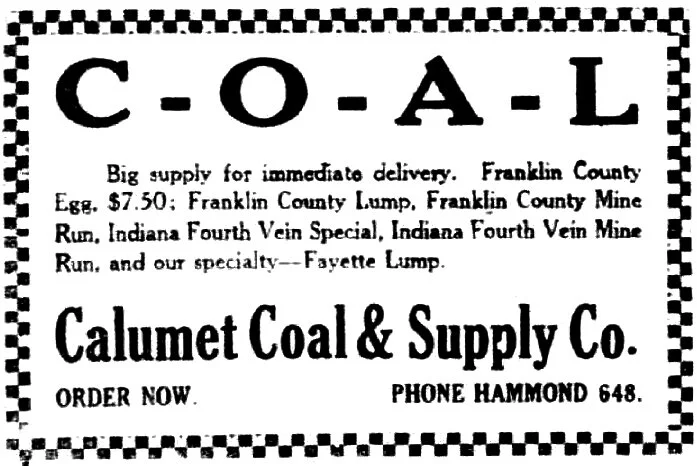Coal In Whiting
Jerry Banik, December 2019
Coal is a commodity that was present everywhere in our area not so long ago. It powered our factories. It cooked our food and heated our water and our homes. For well over a century it has been essential to our steel production. Even today the subject of coal consumption is regularly in the news.
But if Santa Claus plans to put coal in any Whiting or Robertsdale Christmas stockings this year, could he even find a place to buy a few lumps?
By 1910 no fewer than six railroads that hauled coal from America’s mines served a growing Whiting community. Back then heavy industries usually ordered directly from the mine operators, but for retail consumers Whiting had three dealers along our many railroad tracks: Whiting Lumber and Coal, William E. Vater, and J.J. Donegan.
Even as recently as the early 1950s the Hammond City Directory listed “Coal dealers, retail” on Schrage Avenue, Center and Lake Streets, and two on New York Avenue.
Local suppliers carried coal by horse and wagon, and later by truck, to customers’ homes where it was usually shoveled through a chute on the outside of each house.
The chutes had hinged, metal doors, often embossed with the name of a supplier, and they led to a small room or bin in the basement near the home’s furnace. There was a time when most houses in Whiting, Robertsdale and Goose Island had coal bins.
Homeowners in need of a coal resupply had to be familiar with the many varieties available and could choose among them by grade (Franklin County, Indiana Fourth Vein, Pocahontas, Fayette Lump, Old Ben and Montgomery Lump just to name a few), by size (barley, rice, buckwheat, pea, chestnut, egg, range) and by price (usually sold by the ton).
In addition to choosing from the dizzying array of coal grades and sizes Whiting and Robertsdale homeowners also had a choice of many nearby dealers in Hammond, Indiana Harbor, East Chicago and beyond.
Ironically, despite coal being vitally important, it was not always readily available.
Sometimes, particularly in wartime, coal could be difficult to come by. During WWI our government created federal, state and local “Fuel Directors” who were empowered to control supplies, distribution and pricing. They had the authority to require dealers to deliver only limited quantities to any one customer, and to require customers to declare how much they had on hand and that it would be used only for permissible purposes. State directors made it known that the actions they took had the full force of the United States government behind them.
Local residents who lived through the Great Depression tell stories of walking along the railroad tracks when money was scarce in search of pieces of coal that may have fallen off of the scores of train cars en route to the State Line Power plant or one of the many factories just across the Illinois state line.
As time has passed technology, infrastructure improvements, labor issues, government policies and societal shifts have driven a huge drop in the consumption of coal. Kerosene, then natural gas and electricity replaced coal cook stoves. Fuel oil and natural gas replaced coal furnaces in the home and in industry. Railroad and miners’ strikes interrupted coal supplies, sometimes to the extent that the federal government had to intervene. Also, as a result of environmental concerns, coal power today is a much smaller piece of America’s energy pie. Our massive State Line Power plant for decades used coal to fire the boilers for the turbines that generated electricity for the needs of millions. Today it is only a memory. Gone, too, are the metal doors of the coal chutes that decorated Whiting and Robertsdale homes. Those doors are now collectibles that can be purchased on the internet.
But also gone, thankfully, are the coal dust and smoke that blanketed our cities when coal was king.

















